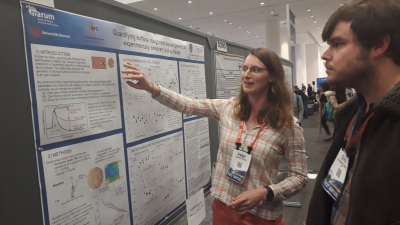Aagje Ejisink
Report of GLOMAR PhD student Aagje Eijsink about her participation in the Fall meeting of the American Geophysical Union (AGU) in San Francisco, USA from 9 to 14 December 2020
The Fall meeting of the American Geophysical Union, or AGU for short, is the largest conference for earth and space science in the world. It took place in San Francisco from 9 to 14 December 2019 and this was a special year, marking the 100 year anniversary of the AGU, meaning even more people attended and many extra sessions were hosted with the overarching topic: “celebrate the past, inspire the future”. From how well-organized it was, you could tell that they are quite experienced in hosting such large events, because in most sessions I didn’t even realize how large it was. Except for the poster hall, which was absolutely huge. The positive part about such a large meeting is that the sessions are highly specialized, with very specific sessions about slow earthquakes, fault healing and lab scale-seismicity, which were interesting for me.
I also enjoyed spending time outside of the oral sessions, like in the poster hall. During poster sessions, it is much easier to make contact with people or to catch up with people you have seen before. Many of the people I met there are fellow PhD students, who are more willing to explain their research at a basic level, which is nice when you are interested in a topic, but don’t know very much about it yet. I also attended a one hour lecture from Emily Brodsky, who is well-known in the field of earthquake research, who gave a sort of overview over the current state of earthquake research, which I very much liked. Since she also knows a lot about my field of research, in the end I went up to her to thank her for her talk and to ask her if she would come to visit my poster the next day. I am very happy that I found the courage to do this, because we had a very useful discussion at my poster the next day. Another talk that I very much enjoyed was an ‘inspiration talk’ as part of the special centennial program, where top scientists from different disciplines within the earthquakes research spoke about what research should focus on, how we can or cannot forecast earthquakes and how the different directions of research should contribute to protect society in the future from earthquake damage. For me, this session was truly inspiring, because it reminded me why the work I do is important and I felt a rush of motivation to continue with my research.
I am very thankful that GLOMAR and my supervisor Matt Ikari supported me to go to this conference, and I would recommend it to all other students who have the possibility. I have shared my work with other people and received useful feedback, I met new people and reconnected with people I met before and I feel inspired to continue working on my research. I do have a few tips from my experiences, namely that when attending such a large meeting you really have to prepare yourself and prioritize what you don’t want to miss and what you would like to see. Also at AGU there are not much organized possibilities for networking, like organized coffee/tea breaks or drinks. So you have to organize something if you want to catch up with people or meet new people. Another thing I learned is that people who arrived one or two days before the meeting started have an advantage as they already get rid of the worst part of the jetlag.



